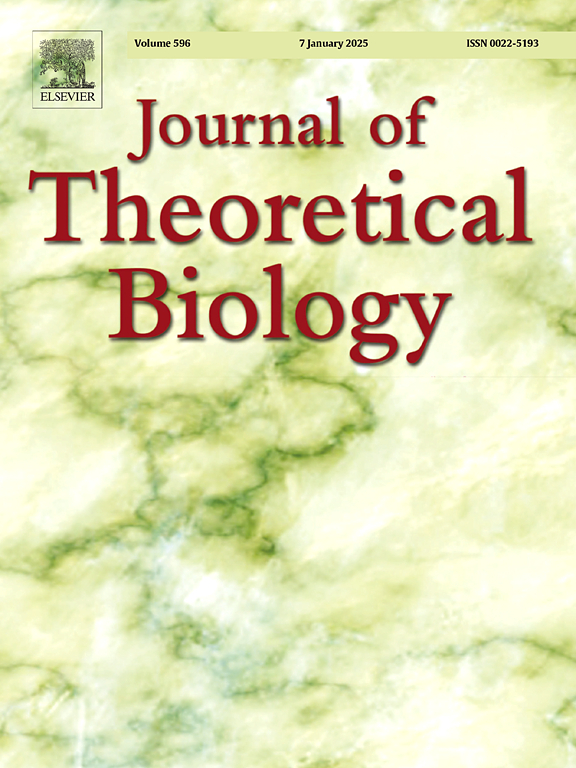统一的α, mu,和tau节奏和他们的β频带谐波特征模式:光谱峰,地形,和反应性
IF 2
4区 数学
Q2 BIOLOGY
引用次数: 0
摘要
目的:在正常成年人中,α、mu和tau节律的频率都在10赫兹左右,范围为7-13赫兹。β节律、mu相关活动和tau相关活动的频率大约是这些频率的两倍。目前的目标是利用神经场理论(NFT)来解释观察到的频率结构和空间地形,并以统一的方式提出所有这些节律的反应性机制,并预测尚未在实验中报道的其他特征。方法:NFT对大量神经元的活动进行平均,预测平均放电率和脑电图特征。它预测了自然活动模式的存在,每种模式都具有特征的空间结构和频率。最低模态支配着大尺度活动,本文使用前四种模态来预测α、mu和tau节律及其二次谐波(包括分裂峰)的光谱、形貌和反应性。结果:皮质丘脑回路延迟决定了α节奏的基本~ 10hz频率和β节奏的~ 20hz频率,并解释了它们在个体-受试者水平上的频率相关性。皮质几何对单个模式的不同影响导致观察到的α和β节律的频率分裂,我们预测mu和tau及其谐波的类似分裂。alpha, mu和tau的空间地形可以用模态结构来解释,振幅叠加而不是功率,我们预测每个节奏的谐波将倾向于与其基本地形相似,尽管可能会出现特定的例外。当模态特征频率差到足以产生分裂峰时,也得到了类似的结果。旋转模式和波前的动力学也解释了对模式。每种节律的阻断或“去同步”可以通过皮质丘脑回路增益的适度减少来解释,通过接近临界状态来放大,我们预测基本和谐波将倾向于串联阻断,这种效应已经在α和β中观察到。矛盾的是,模态分析表明,一个区域的阻塞可能与另一个区域的增强相关,这可能解释了事件相关同步现象。结论:仅用四种皮质丘脑特征模式就获得了α、mu、tau及其谐波的统一解释。结果与各种实验观察结果一致,并对新特征进行了实验可验证的预测。意义:在首次观察人类脑电图的一个世纪之后,这项工作解释并统一了最早检测到的阿尔法节奏及其亲属及其谐波,形成了一个单一的家庭。这为分析和监测活动及其潜在生理学提供了强有力的理论基础,并通过NFT将这些节律与其他现象(如诱发反应)联系起来。本文章由计算机程序翻译,如有差异,请以英文原文为准。
Unification of alpha, mu, and tau rhythms and their beta-band harmonics via eigenmodes: spectral peaks, topography, and reactivity
Objective:The alpha, mu, and tau rhythms all have frequencies of around 10 Hz in normal adult humans, with a range of 7–13 Hz. The beta rhythm, mu-associated activity, and tau-associated activity, are found at around twice those frequencies. The present objective is to use neural field theory (NFT) to explain the observed frequency structure and spatial topography, and to suggest a mechanism of reactivity, of all these rhythms in a unified way, and to predict other features not yet reported experimentally.
Methods: NFT averages over the activity of large numbers of neurons to predict mean firing rates and EEG characteristics. It predicts the existence of natural modes of activity, each with characteristic spatial structure and frequencies. The lowest modes dominate large-scale activity and the first four are used here to predict spectra, topography, and reactivity of alpha, mu, and tau rhythms and their second harmonics, including split peaks.
Results: Corticothalamic loop delays determine the basic Hz frequency of the alpha rhythm, the Hz frequency of the beta rhythm, and explain their frequency correlations on an individual-subject level. Differential effects of cortical geometry on individual modes cause observed frequency splitting of the alpha and beta rhythms and we predict analogous splitting of mu and tau and their harmonics. Spatial topographies of alpha, mu, and tau are explained by modal structure, with amplitudes superposed rather than powers, and we predict that the harmonic of each rhythm will tend to have similar topography to its fundamental, although specific exceptions can occur. Similar results are obtained when modal eigenfrequencies differ sufficiently to give rise to split peaks. Dynamics of rotating patterns and wavefronts are also explained in terms of pairs of modes. Blocking or “desynchronization” of each rhythm can be accounted for by modest decreases in corticothalamic loop gains, magnified by proximity to a critical state, and we predict that fundamental and harmonic will tend to be blocked in tandem, an effect that has already been observed for alpha and beta. Paradoxically, modal analysis implies that blocking in one region can correlate with enhancement in another, which may account for the phenomenon of event-related synchronization.
Conclusions: A unified explanation of alpha, mu, tau, and their harmonics is obtained in terms of just four corticothalamic eigenmodes. The results are consistent with a wide variety of experimental observations and experimentally testable predictions of new features are made.
Significance: A century after the first observations of human EEG, this work explains and unifies alpha, the earliest detected rhythm, with its relatives and their harmonics to form a single family. This provides a strong theoretical basis for analysis and monitoring of activity and its underlying physiology and, via NFT, for linking these rhythms to other phenomena such as evoked responses.
求助全文
通过发布文献求助,成功后即可免费获取论文全文。
去求助
来源期刊
CiteScore
4.20
自引率
5.00%
发文量
218
审稿时长
51 days
期刊介绍:
The Journal of Theoretical Biology is the leading forum for theoretical perspectives that give insight into biological processes. It covers a very wide range of topics and is of interest to biologists in many areas of research, including:
• Brain and Neuroscience
• Cancer Growth and Treatment
• Cell Biology
• Developmental Biology
• Ecology
• Evolution
• Immunology,
• Infectious and non-infectious Diseases,
• Mathematical, Computational, Biophysical and Statistical Modeling
• Microbiology, Molecular Biology, and Biochemistry
• Networks and Complex Systems
• Physiology
• Pharmacodynamics
• Animal Behavior and Game Theory
Acceptable papers are those that bear significant importance on the biology per se being presented, and not on the mathematical analysis. Papers that include some data or experimental material bearing on theory will be considered, including those that contain comparative study, statistical data analysis, mathematical proof, computer simulations, experiments, field observations, or even philosophical arguments, which are all methods to support or reject theoretical ideas. However, there should be a concerted effort to make papers intelligible to biologists in the chosen field.

 求助内容:
求助内容: 应助结果提醒方式:
应助结果提醒方式:


